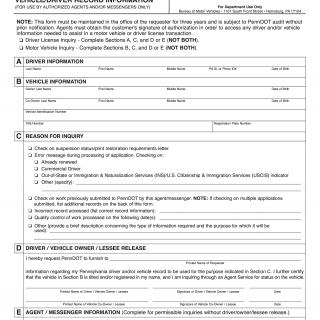Form MV-753 - Authorization for Release of Motor Vehicle / Driver Record Information
The MV-753 form, officially titled "Authorization for Release of Motor Vehicle/Driver Record Information," is a Pennsylvania Department of Transportation (PennDOT) document designed to grant authorized agents or messengers permission to access an individual’s driver and vehicle records. This form plays a crucial role in ensuring privacy while allowing legitimate access for processing applications, verifying vehicle status, or resolving record errors.
Purpose and Applicability of the Form
The form serves multiple purposes:
- Checking suspension status or printing a restoration requirements letter.
- Resolving errors encountered during application processing.
- Verifying work previously submitted by an agent or messenger.
- Quality control of work processed for a driver or vehicle record.
- Authorizing specific agents to inquire about driver or vehicle records on behalf of the owner or lessee.
This form must be completed whenever an agent or messenger requires access to someone else’s motor vehicle or driver record information. Individuals themselves only need to fill it out if an agent is acting on their behalf.
Detailed Section Breakdown
Section A – Driver Information
Includes the full legal name, date of birth, and Pennsylvania driver license or photo ID number. Accurate completion is critical to ensure the right record is accessed. Common mistakes include misspelling names or entering incorrect ID numbers, which may delay processing.
Section B – Vehicle Information
Captures ownership details, including co-owners, vehicle identification number (VIN), title number, and registration plate. Ensure that all co-owner information is correctly entered to avoid disputes or incomplete inquiries.
Section C – Reason for Inquiry
Specifies why the record information is needed. Applicants should clearly mark the purpose and provide additional details if selecting "Other." Mistakes here, such as vague or incorrect purposes, can lead to form rejection or delays.
Section D – Driver/Vehicle Owner/Lessee Release
Requires the signature of the owner or lessee authorizing the release of their records. Without this consent, agents cannot legally access records. Remember to date and print names legibly.
Section E – Agent/Messenger Information
Filled by the agent or messenger accessing the records. This section ensures accountability, listing employee names, user IDs, and signatures. Forms must be retained for three years and are subject to PennDOT audit.
Practical Recommendations for Completing the Form
- Double-check spelling of names and numbers to prevent delays.
- Provide clear, specific reasons in Section C.
- Attach copies of required identification if requested by PennDOT.
- Ensure all signatures are legible and dated correctly.
- Keep a copy of the completed form for personal records.
Examples of Real-Life Use Cases
- Vehicle Sale: A car dealer acting as an agent requests the current title status of a vehicle to complete a sale.
- Driver License Issue: An agent verifies suspension status to assist a customer renewing a license.
- Record Error Correction: A registered owner notices incorrect VIN details in PennDOT’s system and authorizes an agent to request correction.
- Quality Control: A fleet management company audits previously submitted vehicle registrations.
Supporting Documents Typically Required
- Driver’s Pennsylvania license or state-issued photo ID.
- Proof of vehicle ownership (title or registration).
- Power of attorney or authorization letter if an agent submits on behalf of the owner.
- Additional identification for co-owners if applicable.
FAQ
- Who can submit this form? Only the vehicle/driver or an authorized agent/messenger.
- When is it required? Required whenever someone other than the owner or lessee accesses driver/vehicle records.
- Can multiple vehicles be listed? Yes, list additional vehicles on the back if necessary.
- What happens if the form is incomplete? PennDOT may reject the inquiry or delay processing.
- How long should I keep the form? Retain for at least three years, as PennDOT may audit it without notice.
- Are electronic signatures accepted? Typically, original handwritten signatures are required.
- Is there a fee? No, the form itself is free, but associated inquiries may carry fees.
Micro-FAQ (Ultra-Short Answers)
- Purpose: Authorize record release.
- Who files: Owner or agent.
- Deadline: When an agent needs access.
- Attachments: ID, proof of ownership.
- Submitted to: PennDOT Bureau of Motor Vehicles.
- Co-owner info required: Yes, if applicable.
- Multiple vehicles allowed: Yes, list separately.
- Retention period: 3 years.
- Electronic submission: Not standard.
- Audit possible: Yes, anytime within retention period.
Navigation
- Related forms in Texas
- Other state forms
- Legal guides and instructions
Form Details
Form Name: Authorization for Release of Motor Vehicle/Driver Record Information
Form Number: MV-753
Region: Pennsylvania
Date of Revision: 7-15 (July 2015)

